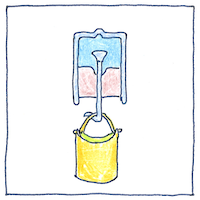Galileo Galilei
kinematics

|
Kinematics
Laws of motion were established by Aristotle, but Aristotle got them wrong. Disregarding Aristotle, and disregarding air resistance, falling objects all fall with the same rate of increase. And disregarding friction, objects that move horizontally can continue to move without anything pushing them. Galileo formulated the mathematical laws of motion, even though Aristotle said that mathematics could describe only abstract immutable things.
Disregarding authority
According to Galileo (disregarding Aristotle’s authority) experiment and mathematics reveal the laws of the universe. Galileo studied the pendulum, invented the thermoscope, invented the hydrostatic balance, and improved the telescope. Galileo supported the Copernican notion that the earth circles the sun, and pointed out that the stars were not fixed in the heavens. Galileo discovered the four moons of Jupiter and noted they orbited Jupiter instead of orbiting the earth. Galileo observed that the moon has mountains and craters so it was not a translucent and perfect sphere, and he observed sunspots, which showed that the heavens were not perfect or unchanging.
Falling
A large ball falls just as fast as a small ball, even though Aristotle said the heavier would fall faster. If the bigger they are, the harder they fall, then the bigger would be old Aristotle.



Galileo did not get everything right. He thought that the tides were not related to the moon, as Johannes Kepler had claimed, and he misinterpreted the rings of Saturn. In his defense, one must realize that his best telescope magnified the size of objects only 30 times.
Because falling objects moved too fast to accurately time, instead of dropping metal balls from the Tower of Pisa, Galileo studied pendulums and bronze balls rolling down inclined grooves. He timed these by collecting water released from a reservoir and carefully weighing it.
Isaac Newton incorporated Galileo’s law of horizontal motion, the principle of inertia, into his first law of motion.
Although Christiaan Huygens is credited with inventing the pendulum clock in the 1650s, Galileo realized that a pendulum would provide a more accurate clock and invented an escapement mechanism for it in 1642.
See also in The book of science:
Readings in wikipedia: